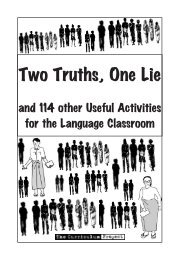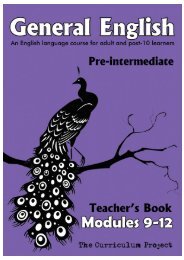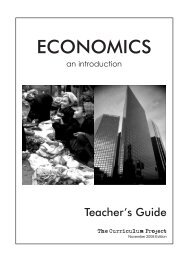Student's Book â Dec 2009 (5.9mb) - The Curriculum Project
Student's Book â Dec 2009 (5.9mb) - The Curriculum Project
Student's Book â Dec 2009 (5.9mb) - The Curriculum Project
Create successful ePaper yourself
Turn your PDF publications into a flip-book with our unique Google optimized e-Paper software.
6. Nan Zhao (nahn zow)<strong>The</strong> Thai peoples were the last major ethnic group to come into Southeast Asia from China. Aswith the other groups, few details are available. <strong>The</strong> Thais probably originally lived in China’sSichuan province. <strong>The</strong>y migrated south to Yunnan to escape becoming part of the growingChinese empire. In the 9th century, Nan Zhao successfully attacked Burma and Vietnam but wasdestroyed by the Mongols in 1253 AD.Even before that time, small groups of Thais moved out. One group, the Shans, settled in easternBurma. Others, like the Lao, settled on the Khorat (ko-rat) Plateau and the upper Mekong valley.By the thirteenth century the Thais began to be more aggressive. In several places along the NanRiver (a tributary of the Chao Phraya), Thais set up independent city-states. <strong>The</strong> most importantof these was Sukhothai, founded around 1238 on the upper Nan river, and Lanna, further north onthe same river.7. Lan Xang (lahn-zahng)<strong>The</strong> Lao communities on the Khorat Plateau and the upper Mekong were not united under aLao ruler until the 14th century. Lao legends say that their kingdom got started when the son ofthe ruler of Luang Prabang fled to exile in Cambodia. <strong>The</strong>re, his wife had a son. <strong>The</strong> Khmersgave this prince, Fa Ngum, an army, and he marched up the Mekong River. With his army heconquered central and southern Laos, and Luang Prabang. He became a king in 1353. <strong>The</strong> newkingdom was named Lan Xang, the “Land of a Million Elephants.”8. Khmer<strong>The</strong> first Khmer kingdom was known as Chenla (chen-lah). It did not have a strong government.It prospered in the 7th century, but in 706 it split into two states, known as “Land Chenla” (Laos)and “Water Chenla” (Cambodia). Land Chenla remained a unified state for some time, but WaterChenla became five smaller states because of disagreements over who should rule. At the end ofthe 8th century, all of Water Chenla came under the control of one of Java’s monarchs.<strong>The</strong> second Khmer kingdom was at Angkor. Land Chenla submitted peacefully to Angkor’s rule.<strong>The</strong> states in Thailand and Malaya did the same during the reign of Khmer king Suryavarman(soohr-yah-vahr-mahn) I (1002-50). <strong>The</strong> next two generations of Khmer kings continued to fightand gain territory in the region and led attacks against the Burmese and the Vietnamese.9. Malacca<strong>The</strong> first Muslim State in Southeast Asia with real power was Malacca, founded in 1401 by afugitive Sumatran prince named Parameswara (pah-rah-mes-wah-rah). Malacca had a superblocation for commerce, right at the narrowest point of the Malacca Straits. <strong>The</strong> kingdoms of Siamand Majapahit (mah-jah-pah-hit) both controlled the Malay peninsula at different times.exerciseorderingRead about one of the peoples of Southeast Asia. Put the information into this timeline:500BC 1AD 2000ADLook at other timelines. Compare events that have happened in the different countriesin Southeast Asia.extensioncomprehensionIn groups, make a question for each of the states described in the previous pages.Test the other groups.23













![[Eng] Nov 2012 DRAFT - The Curriculum Project](https://img.yumpu.com/45590859/1/184x260/eng-nov-2012-draft-the-curriculum-project.jpg?quality=85)


